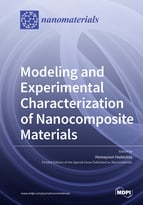Modeling and Experimental Characterization of Nanocomposite Materials
A special issue of Nanomaterials (ISSN 2079-4991).
Deadline for manuscript submissions: closed (25 September 2019) | Viewed by 25267
Special Issue Editor
Interests: polymer composite materials; nanocomposites; fatigue of polymer composites; multiscale modeling
Special Issues, Collections and Topics in MDPI journals
Special Issue Information
Dear Colleagues,
The possibilities to enhance the desired properties of composites by additive nanoscale secondary reinforcement attracted a large amount of interest, both in the research arena and in industrial applications. The research in this field has been oriented towards experimental, theoretical and numerical modeling. As a result, great progress has been made on many fronts, including manufacturing processes and scaling up; characterizing the interface between the additives and the matrix; functionalizing the nanoparticles to enhance the bonding with the matrix and better dispersion, characterizing the mechanical, thermal and electrical properties; and theoretical/computational analysis of nanocomposite responses under different types of loading, either embedded in the fiber composites or as a polymer nanocomposites.
This Special Issue will bring together researchers from different branches of science and engineering disciplines, working on experiments and modeling of nanocomposites into one volume. The Guest Editor welcomes papers dedicated to experimental, computational and theoretical aspects dealing with many important state-of-the-art technologies and methodologies regarding the synthesis, fabrication, characterization, properties, design, applications, and both finite element analysis and molecular dynamic simulations of nanocomposite materials and structures. Full papers covering novel topics, extending the frontiers of the science and technology of nanoreinforced composites are encouraged. Reviews covering topics of major interest will be also considered.
Assoc. Prof. Homayoun Hadavinia
Guest Editor
Manuscript Submission Information
Manuscripts should be submitted online at www.mdpi.com by registering and logging in to this website. Once you are registered, click here to go to the submission form. Manuscripts can be submitted until the deadline. All submissions that pass pre-check are peer-reviewed. Accepted papers will be published continuously in the journal (as soon as accepted) and will be listed together on the special issue website. Research articles, review articles as well as short communications are invited. For planned papers, a title and short abstract (about 100 words) can be sent to the Editorial Office for announcement on this website.
Submitted manuscripts should not have been published previously, nor be under consideration for publication elsewhere (except conference proceedings papers). All manuscripts are thoroughly refereed through a single-blind peer-review process. A guide for authors and other relevant information for submission of manuscripts is available on the Instructions for Authors page. Nanomaterials is an international peer-reviewed open access semimonthly journal published by MDPI.
Please visit the Instructions for Authors page before submitting a manuscript. The Article Processing Charge (APC) for publication in this open access journal is 2900 CHF (Swiss Francs). Submitted papers should be well formatted and use good English. Authors may use MDPI's English editing service prior to publication or during author revisions.
Keywords
- Multiscale modeling
- Nanocomposites
- Composites
- Polymers
- Nanoparticles







